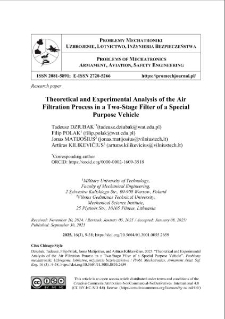Our Digital Library contains 1 868 digital objects
Object
Title: Theoretical and Experimental Analysis of the Air Filtration Process in a Two-Stage Filter of a Special Purpose Vehicle
Alternative title:
Contributor:
Filip POLAK, Jonas MATIJOŠIUS, Artūras KILIKEVIČIUS
Abstract:
Two-stage (multi-cyclone-pore-partition) air filters are what protects a vehicle's engine from sucking in mineral dust particles that cause an accelerated wear of internal components. Information on the air filtration process taking place in a two-stage system (multicyclone-baffle filter) of a vehicle's internal combustion engine is not provided often in the available literature. The purpose of this study was to experimentally evaluate paper filters operating directly behind and without a multicyclone system. An original methodology was used, consisting in testing a single cyclone and a paper filter with a suitably sized surface area. While testing the assembly (cyclone-paper filter test), parameters corresponding to those under which two-stage air filters actually operate were maintained, including filtration speed in the paper filter, dust concentration in the air and the cyclone’s inlet velocity. Filtration efficiency and accuracy, as well as pressure drop value were among the parameters determined as a function of dust mass delivered to the unit (cyclone-paper filter) or directly to the filter. The study showed that a paper filter operating downstream from a cyclone operates four times longer before reaching the permissible pressure drop value. During the initial (short) filtration period, separation efficiency values obtained were much lower (w0 = 93.3% without and wc0 = 53.6% with the cyclone, respectively) than the required threshold of 99.5%. The air behind the paper filter contained dust grains with a size of 35-40 μm, compared to the required parameter of 2-5 μm. Further operation of the filter is characterized by a high separation efficiency of 99.9%, a high accuracy dpmax of 2-5 μm and a continuously increasing pressure drop, with the said drop being more intense in the filter without the cyclone system.
Place of publishing:
Warszawa
Publisher:
Date created:
Date submitted:
Date accepted:
Date issued:
Extent:
Identifier:
oai:ribes-88.man.poznan.pl:2740
Call number:
Electronic ISSN:
Print ISSN:
Language:
License:
Rights holder:
Starting page:
Ending page:
Volume:
Journal:
Keywords:
Object collections:
Last modified:
Oct 17, 2025
In our library since:
Oct 17, 2025
Number of object content hits:
0
All available object's versions:
https://ribes-88.man.poznan.pl/publication/3081
Show description in RDF format:
Show description in OAI-PMH format:
| Edition name | Date |
|---|---|
| Theoretical and Experimental Analysis of the Air Filtration Process in a Two-Stage Filter of a Special Purpose Vehicle | Oct 17, 2025 |

